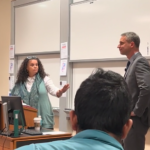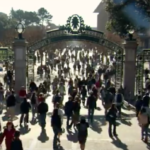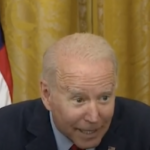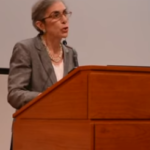Words That May Not Be Spoken About Black Law Students
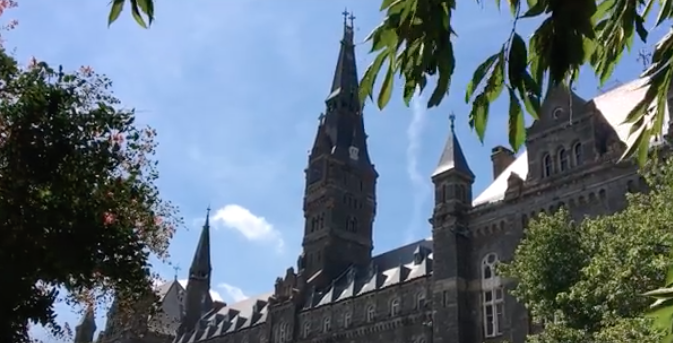
As one more bit of evidence that universities have become “islands of repression on a sea of freedom,” Georgetown University’s Law Center is currently experiencing paroxysms of anti-racist fervor after two adjunct professors teaching a joint negotiations class, Sandra Sellers and David Batson, were unknowingly recorded bemoaning the low academic performance of their black law students.
“I hate to say this,” Sellers is recorded as saying to Batson in the 43-second video clip made in February that both professors thought was a private conversation, “I ended up having this, you know, angst every semester that a lot of my lower ones are blacks. Happens almost every semester. And it’s like, ‘Oh, come on!’ You know? I get some really good ones but there’s usually some that are just plain at the bottom. It drives me crazy. Of course, there are the good ones . . . but come on . . . .”
Once the offending video clip was posted on social media, the Georgetown Law campus erupted with howls of indignation, rage, and calls for the termination of both Sellers and Batson.
The Georgetown University Law Center black faculty immediately issued a condemnatory statement, suggesting that Sellers’ “Zoom comments reveal what we see as an underlying, damaging perception of Black law students that is grounded in white supremacist thought.” They further asserted that “Racializing student performance casually was in itself unnecessary and recklessly conjured centuries old expectations of Black intellectual capacity and performance,” and by “singling out Black students, the professor flagrantly and unfairly stigmatized them and in the process both revealed and propagated racial, and overtly white supremacist stereotypes about the intellectual ability of Black students . . , undermin[ing] our Black students’ freedom to focus on learning [so that] we are deeply concerned that our Black students will (rationally) spend their time worried that their law professors may hold white supremacist viewpoints.”
A petition calling for Sellers’ termination from the Black Law Students Association garnered more than 1,900 signatures and a statement by the group suggested, although without evidence, that “. . . Sellers was caught and her racism was broadcast for the world to see. These racist statements reveal not only Sellers’ beliefs about Black students in her classes, but also how her racist thoughts have translated to racist actions. Professor Sellers’s bias has impacted the grades of Black students in her classes historically, in her own words.”
William Treanor, the Law Center’s Dean, of course, entered the fray, as well, issuing several statements on the matter, noting, in addition to describing the content of the video as “abhorrent,” that “The comments about Black students, made in a conversation between two adjunct faculty . . . had a profound and adverse impact on Black students. But the harm inflicted did not stop there. Our entire community is grappling with the painful and difficult effects and the significance of the video.”
In addition to firing Sellers and orchestrating the resignation of Batson, the Dean committed the Law Center to the predictable anti-racism initiatives being initiated on other campuses, including non-discrimination training, “a reporting system that allows students to document bias-related incidents in the classroom . . ,” and the development of “curricular materials addressing racial justice, racial inequities, and the experiences and agency of traditionally marginalized groups.”
In other words, because a professor had uttered some words that were factually correct, because she had told the truth about the performance of black law students at Georgetown (a pattern, not inconsequentially, consistent with that of black law students at many other elite and non-elite law schools), not only was she censured for her comments, but the entire Georgetown diversity bureaucracy was to be fortified in the name of racial justice and anti-racism.
In 2018, a similar racism frenzy erupted at the University of Pennsylvania when one of its law professors, Amy Wax, made similar observations in a video interview concerning the dark side of affirmative action: the failure of black law students to excel on her own campus. In the interview with Glen Loury, an economist at Brown University, Wax brought up one of the flaws critics see in affirmative action programs, something known as the “mismatch effect.”
The subject of a book entitled Mismatch: How Affirmative Action Hurts Students It’s Intended to Help, and Why Universities Won’t Admit It by UCLA law professor Richard Sander (and co-author Stuart Taylor), the mismatch effect is the result of black students gaining admission to law schools as a result of racial preferences, so that their academic records and preparation is weaker than that of their non-black fellow students. Because they then must compete academically with students who are better prepared and whose educational background has equipped them for the rigors of law education, black students have chronically performed poorly when compared to their non-black peers. As Sander put it, “nearly all blacks [are placed] at an enormous academic disadvantage in the schools they attend.”
In the video interview, specifically, Professor Wax noted that “I don’t think I’ve ever seen a black law student graduate in the top quarter of her classes and rarely in the top half,” a situation that plays itself out similarly in many law schools which have aggressively recruited minority students in their zeal to have diverse and inclusive campuses.
Sander’s fastidious collection of data confirms the anecdotal, but valid, observations of professors Sellers, Batson, and Wax. In a 2006 briefing before The United States Commission on Civil Rights, for example, Sander’s testimony noted that “Half of African-American students are in the bottom ten percent of their law school class at the end of the first year;” that “African-Americans have 2.5 times the drop-out rate of their white counterparts; four times the initial bar failure rate; and six times the chance of never passing the bar,” and that “Two-thirds of black students who drop out after the first year are in the bottom five percent of their class.” Law school graduates are unique in that their success can be measured fairly and comprehensively since all law students eventually take a common bar exam, and here black students perform poorly, as well, failing the bar exam at four times the rate of white graduates. According to Sander’s estimates, more than 40 percent of black students who enter law school never become part of that profession.
It is important to remember that Sander is not suggesting in his research and mismatch theory that black law students are less intelligent than their non-black fellow students or inherently unable to master the knowledge and skills required of law students and lawyers. Of course, the race-sensitive woke students and administrators at Georgetown and Penn assumed that is exactly what the errant professors meant, which is why the videos caused such furor on the respective campuses and why the indignant mob sought to purge the law schools of anyone who would question both the wisdom and efficacy of race-based preferences in law school admissions and the resulting performance of black law students. But non-black students are not aggressively recruited to attend law schools for which they are not academically prepared.
The reflexive answer to why black students do poorly at law school, of course, often is, as was assumed at Georgetown in this latest episode, that the white supremacy and implicit bias of the professor negatively affect grades of minority students, that it is the racism of the professor causing black students to lag behind and not the lack of study and comprehension skills of students who have been admitted to schools for which they are ill-prepared.
The letter from Georgetown’s black faculty castigating Sellers for the sentiments expressed in the video suggested that she was not only possibly a racist but that the bigotry revealed in her comments about her black students’ achievement itself limits her black students’ success.
“The professor’s comments also raise serious concerns about whether her own bias may be driving the outcomes she observed in her class,” they wrote, without ever considering whether there was truth to her comments or not, “Broad statements as to the intellectual ability of students based on their race reflect more poorly on the speaker than those spoken of. Such beliefs spur behavior that is unlikely to create a fair playing field for all students in the classroom. If you expect Black students to behave poorly, your classroom performance as a professor and your grading can operate to confirm that bias. Your Black students then suffer irreparable harm as they experience the consequences of poor grades driven by racial bias.”
In an interview with The Hoya, Georgetown’s student newspaper, law student Quincey Wilson interpreted Seller’s comments similarly, assuming they revealed a latent bigotry that would negatively affect black students’ grades. “It’s already hard as it is being a law student in general,” Wilson said. “But to have other pressure on you as a Black student, to feel that no matter how hard you’re working, some professors like Professor Sellers can look down on you or give you a worse review just because of the color of your skin — it’s depressing is what it is.”
Perhaps more depressing is the reality that professors—and often students, too—are regularly censured and condemned for having views that contradict prevailing orthodoxies, even when they are discussing factually correct ideas, as was the case here, and not merely personal opinions. The diversocrats on American campuses may recoil at the notion that their efforts to achieve racial equity have unintended, even harmful, consequences, but suppressing the speech of and punishing those who reveal some of the defects of affirmative action is a serious violation of academic freedom, not to mention the willful blindness of progressives who seem to care more about appearing virtuous than they do about contributing to actual constructive social change.

